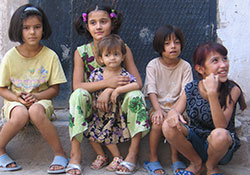Data and statistics

WHO/Malin Bring
Gender-based discrimination affects health
-
Survey data from several countries in the Region show that women in all countries are subject to violence by their intimate partners. In the European Region (EU), 1 in 5 women have been victims of domestic violence.
-
Traditional practices such as bride kidnapping and honour killings are present in the Region. Female genital mutilation has been documented among migrant communities.
Gender interaction with other socioeconomic determinants increases risk and vulnerability
-
A study comparing statistics on pregnancy outcomes in immigrant versus native women in Europe from 1966 to 2004 found that immigrant women faced a 43% higher risk of bearing a low-birth-weight child, a 24% higher risk of pre-term delivery, 50% higher risk of perinatal mortality, and 61% greater risk of bearing a child with congenital malformations.
-
There is evidence that boys from different foreign backgrounds who live in western Europe are at a higher risk of injury than boys with a European background.
-
Immigrants may also be more vulnerable to other types of accidents: data from Germany indicate that non-German children aged 5–9 years are more vulnerable to traffic and other injuries than German children of the same age.
Gender inequities disadvantage women’s access to and control of resources
-
Women form the majority of the unemployed, earn less than men and perform most of the part-time and unpaid jobs.
-
In EU countries, in 2006, women earned an average of 15% less per hour than men, 58% of them were unemployed compared to 72% of men.
-
Average representation of women in national governments of the EU is 23%.
-
These discrepancies are even greater in the Eastern part of our region. For example, statistics from 2009 show that, in Albania, women earn an estimated US$ 4954 per year, while men earn US$ 9143.
Exposure to risk and vulnerability is determined by gender norms and behaviours that have a negative effect on women’s and men’s health
-
In the European Region, men account for more than 80% of young adult fatalities from road traffic accidents.
-
Evidence from all over Europe shows that, from the age of 1–2 onwards, reported injury rates are higher for boys than girls, with boys consistently more likely to report having had a medically attended injury.
-
Men are almost five times more likely to commit suicide than women, in all countries of the European Region while deliberate self-harm is more frequent among women.
-
Women are between two and three times as likely as men to be diagnosed as suffering from depression, the most common mental health disorder.
-
Harmful use of alcohol is a strongly gender-determined behaviour which increases men’s risk to neuropsychiatric disorders and other noncommunicable diseases such as cardiovascular diseases, cirrhosis of the liver and cancers.
-
Boys are significantly more likely to be overweight in the majority of countries responding to the Health Behaviour in School-aged Children (HBSC) survey at age 13–15. However, more girls aged 13 and 15 in all countries think they are overweight.
-
Female rates of smoking are on the rise in the Region, while studies show that girls are more vulnerable than boys to the impact of smoking as to respiratory symptoms and lung function.
-
While men still comprises the majority of new HIV cases, women account for an increasing proportion.



